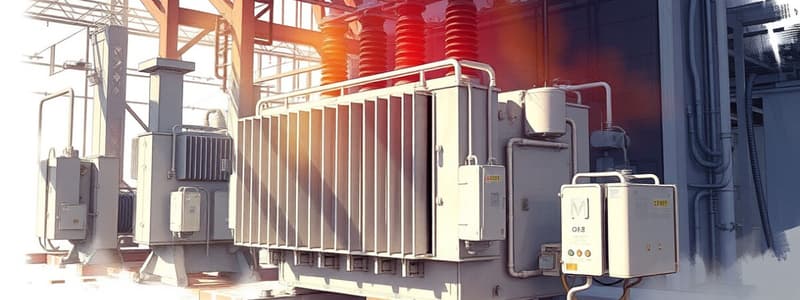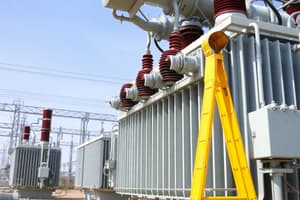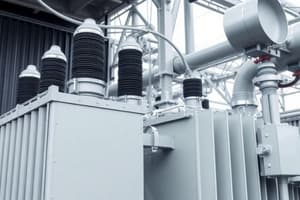Podcast
Questions and Answers
What is the permissible deviation when comparing measured transition resistor values to the values on the rating plate?
What is the permissible deviation when comparing measured transition resistor values to the values on the rating plate?
Where should the measurement of each transition resistor be taken?
Where should the measurement of each transition resistor be taken?
What range of values is expected for each transition resistor?
What range of values is expected for each transition resistor?
What should be done before measuring the transition resistors?
What should be done before measuring the transition resistors?
Signup and view all the answers
What is the primary function of the trip lever in the spring energy accumulator?
What is the primary function of the trip lever in the spring energy accumulator?
Signup and view all the answers
Which tool is necessary for setting the diverter switch before making measurements?
Which tool is necessary for setting the diverter switch before making measurements?
Signup and view all the answers
What should be the condition of the tap changer head before installing the diverter switch unit?
What should be the condition of the tap changer head before installing the diverter switch unit?
Signup and view all the answers
Which component should be used for flushing the diverter switch during cleaning?
Which component should be used for flushing the diverter switch during cleaning?
Signup and view all the answers
What is the primary risk of using alternative cleaning agents like organic solvents for the diverter switch?
What is the primary risk of using alternative cleaning agents like organic solvents for the diverter switch?
Signup and view all the answers
What is noted before starting the inspection of the diverter switch unit?
What is noted before starting the inspection of the diverter switch unit?
Signup and view all the answers
What happens if the tap changer head is not properly closed?
What happens if the tap changer head is not properly closed?
Signup and view all the answers
Which screw specification is required for securing the tap changer head cover?
Which screw specification is required for securing the tap changer head cover?
Signup and view all the answers
Which of the following is NOT a component associated with the inspection of the diverter switch unit?
Which of the following is NOT a component associated with the inspection of the diverter switch unit?
Signup and view all the answers
What could be a consequence of not performing a thorough cleaning of the diverter switch unit?
What could be a consequence of not performing a thorough cleaning of the diverter switch unit?
Signup and view all the answers
How is the total wear of a pair of contacts calculated?
How is the total wear of a pair of contacts calculated?
Signup and view all the answers
What value should be used for K if it is unknown during inspection?
What value should be used for K if it is unknown during inspection?
Signup and view all the answers
When measuring contact wear, what must be ensured about the contact tips?
When measuring contact wear, what must be ensured about the contact tips?
Signup and view all the answers
Which measurement should be taken while the contact is closed?
Which measurement should be taken while the contact is closed?
Signup and view all the answers
Which section provides procedures for replacing diverter switch contacts?
Which section provides procedures for replacing diverter switch contacts?
Signup and view all the answers
What action should be performed after disassembling the sectorial contact shells?
What action should be performed after disassembling the sectorial contact shells?
Signup and view all the answers
What is the recommended procedure if the thickness of contact tips varies?
What is the recommended procedure if the thickness of contact tips varies?
Signup and view all the answers
What is the expected value of S between contact bridge and counterpiece while the contact is closed?
What is the expected value of S between contact bridge and counterpiece while the contact is closed?
Signup and view all the answers
What is the recommended action when approximately 1,000,000 switching operations have been reached?
What is the recommended action when approximately 1,000,000 switching operations have been reached?
Signup and view all the answers
At what point must the diverter switch unit be replaced at the latest?
At what point must the diverter switch unit be replaced at the latest?
Signup and view all the answers
What is the maximum number of tap change operations recommended per year without needing a stationary oil filter unit?
What is the maximum number of tap change operations recommended per year without needing a stationary oil filter unit?
Signup and view all the answers
Which type of oil filter unit is obligatory for tap changers with a U_y > 245 kV?
Which type of oil filter unit is obligatory for tap changers with a U_y > 245 kV?
Signup and view all the answers
How frequently must an inspection be carried out, regardless of the number of operations listed?
How frequently must an inspection be carried out, regardless of the number of operations listed?
Signup and view all the answers
For tap changers with which current rating must an oil filter unit type 51 be used when the operations exceed a certain threshold?
For tap changers with which current rating must an oil filter unit type 51 be used when the operations exceed a certain threshold?
Signup and view all the answers
What is the limit for switching operations before needing to contact Technical Service?
What is the limit for switching operations before needing to contact Technical Service?
Signup and view all the answers
Which RM model has the highest switching operations limit noted?
Which RM model has the highest switching operations limit noted?
Signup and view all the answers
Which statement is true regarding the use of Ok and Not o.k. labels in the context provided?
Which statement is true regarding the use of Ok and Not o.k. labels in the context provided?
Signup and view all the answers
What can be inferred about the pattern of status labeling in the presented content?
What can be inferred about the pattern of status labeling in the presented content?
Signup and view all the answers
How might the labeling on each level affect interpretation of the data?
How might the labeling on each level affect interpretation of the data?
Signup and view all the answers
What does the presence of multiple Ok labels imply about the content's structure?
What does the presence of multiple Ok labels imply about the content's structure?
Signup and view all the answers
Which of the following best describes how one might view the term Not o.k. based on the content?
Which of the following best describes how one might view the term Not o.k. based on the content?
Signup and view all the answers
What might the frequent occurrence of Not o.k. labels signify regarding the approach taken?
What might the frequent occurrence of Not o.k. labels signify regarding the approach taken?
Signup and view all the answers
What aspect of the labeling system is potentially misleading in the presented content?
What aspect of the labeling system is potentially misleading in the presented content?
Signup and view all the answers
Which label likely carries the most weight in terms of urgency for action?
Which label likely carries the most weight in terms of urgency for action?
Signup and view all the answers
The diverter switch unit should be withdrawn in the adjustment position marked by a circle.
The diverter switch unit should be withdrawn in the adjustment position marked by a circle.
Signup and view all the answers
It is necessary to operate the motor drive while the tap changer is uncoupled.
It is necessary to operate the motor drive while the tap changer is uncoupled.
Signup and view all the answers
The stop valve must be closed before lowering the oil level.
The stop valve must be closed before lowering the oil level.
Signup and view all the answers
The protective relay RS 2001 is installed for monitoring the oil return pipe.
The protective relay RS 2001 is installed for monitoring the oil return pipe.
Signup and view all the answers
The bleeder screw is only necessary for the oil return pipe and not for the suction pipe.
The bleeder screw is only necessary for the oil return pipe and not for the suction pipe.
Signup and view all the answers
The tap changer head does not require an inspection glass for the position indicator.
The tap changer head does not require an inspection glass for the position indicator.
Signup and view all the answers
Trip the motor protective switch to prevent electrical operation of the motor drive.
Trip the motor protective switch to prevent electrical operation of the motor drive.
Signup and view all the answers
A coupling bracket is used solely for connecting the oil conservator to the motor drive.
A coupling bracket is used solely for connecting the oil conservator to the motor drive.
Signup and view all the answers
The maximum voltage rating for the tap changer is 170 kV.
The maximum voltage rating for the tap changer is 170 kV.
Signup and view all the answers
To ensure safety, the working area must be clearly marked out before starting the inspection.
To ensure safety, the working area must be clearly marked out before starting the inspection.
Signup and view all the answers
On-load tap changers are designed specifically for use with oil filter units.
On-load tap changers are designed specifically for use with oil filter units.
Signup and view all the answers
The oil filling quantity for the tap changers varies from 160 to 210 litres.
The oil filling quantity for the tap changers varies from 160 to 210 litres.
Signup and view all the answers
The type RM on-load tap changers is identified by a higher switching operations limit than the type R.
The type RM on-load tap changers is identified by a higher switching operations limit than the type R.
Signup and view all the answers
Inspection instructions for on-load tap changers are irrelevant to their operational safety.
Inspection instructions for on-load tap changers are irrelevant to their operational safety.
Signup and view all the answers
The diverter switch can only be withdrawn when the equipment is at its highest operating position.
The diverter switch can only be withdrawn when the equipment is at its highest operating position.
Signup and view all the answers
Ground cables and switches must be visibly grounded as a safety measure.
Ground cables and switches must be visibly grounded as a safety measure.
Signup and view all the answers
A diverter switch unit should never be replaced unless it is confirmed to have reached operational limits.
A diverter switch unit should never be replaced unless it is confirmed to have reached operational limits.
Signup and view all the answers
The length of the diverter switch insert is 1377 mm.
The length of the diverter switch insert is 1377 mm.
Signup and view all the answers
Cleaning agents composed of organic solvents are recommended for cleaning diverter switch units.
Cleaning agents composed of organic solvents are recommended for cleaning diverter switch units.
Signup and view all the answers
The presence of multiple 'Ok' labels indicates a systematic approach to labeling each inspection step.
The presence of multiple 'Ok' labels indicates a systematic approach to labeling each inspection step.
Signup and view all the answers
Lifting height including the lifting device is 1250 mm.
Lifting height including the lifting device is 1250 mm.
Signup and view all the answers
The transformer must be disconnected before inspecting the diverter switch unit.
The transformer must be disconnected before inspecting the diverter switch unit.
Signup and view all the answers
The maximum number of tap change operations recommended per year is irrelevant for maintenance planning.
The maximum number of tap change operations recommended per year is irrelevant for maintenance planning.
Signup and view all the answers
The label 'Not o.k.' is used to signify a low priority for maintenance actions in on-load tap changers.
The label 'Not o.k.' is used to signify a low priority for maintenance actions in on-load tap changers.
Signup and view all the answers
The diverter switch is responsible for transferring current from the preselected tap to the tap in service.
The diverter switch is responsible for transferring current from the preselected tap to the tap in service.
Signup and view all the answers
Ohmic resistors are permanently inserted into the circuit during the tap-change operation.
Ohmic resistors are permanently inserted into the circuit during the tap-change operation.
Signup and view all the answers
The tap selector initiates the tap-change operation by selecting the desired tap on the transformer.
The tap selector initiates the tap-change operation by selecting the desired tap on the transformer.
Signup and view all the answers
Measurement of protective resistors is carried out after the diverter switch's contacts have been replaced.
Measurement of protective resistors is carried out after the diverter switch's contacts have been replaced.
Signup and view all the answers
The functional checks of the motor drive and tap changer are considered part of the inspection tools.
The functional checks of the motor drive and tap changer are considered part of the inspection tools.
Signup and view all the answers
A coupling of the tap changer and the motor drive unit is necessary for proper operation.
A coupling of the tap changer and the motor drive unit is necessary for proper operation.
Signup and view all the answers
Circumstantial measurements of protective resistors can ensure that the operation of the transformer remains unaffected.
Circumstantial measurements of protective resistors can ensure that the operation of the transformer remains unaffected.
Signup and view all the answers
The drive shaft is a component associated with the operation of the tap changer.
The drive shaft is a component associated with the operation of the tap changer.
Signup and view all the answers
The diverter switch must be set to its mid-position to measure the transition contacts a2 and b2.
The diverter switch must be set to its mid-position to measure the transition contacts a2 and b2.
Signup and view all the answers
A significant wear difference of less than 2 mm is permissible when replacing single sectors of the diverter switch insert contact tips.
A significant wear difference of less than 2 mm is permissible when replacing single sectors of the diverter switch insert contact tips.
Signup and view all the answers
To determine the value X on contact tips, only one measurement is required from any of the diverter switch sectors.
To determine the value X on contact tips, only one measurement is required from any of the diverter switch sectors.
Signup and view all the answers
Removal of the support cylinder involves undoing the 12 screws M8 x 20/w.s.13.
Removal of the support cylinder involves undoing the 12 screws M8 x 20/w.s.13.
Signup and view all the answers
Strictly avoiding dropping parts into the diverter switch unit is emphasized as an important safety measure.
Strictly avoiding dropping parts into the diverter switch unit is emphasized as an important safety measure.
Signup and view all the answers
The operating key is used only for securing the contact tips in the diverter switch.
The operating key is used only for securing the contact tips in the diverter switch.
Signup and view all the answers
In all measurements of the diverter switch, only the contact tips need to be assessed without considering the transition contacts.
In all measurements of the diverter switch, only the contact tips need to be assessed without considering the transition contacts.
Signup and view all the answers
It is permissible to replace only the damaged contact tips rather than the entire diverter switch insert when wear is detected.
It is permissible to replace only the damaged contact tips rather than the entire diverter switch insert when wear is detected.
Signup and view all the answers
Study Notes
Transformer Maintenance and Inspection
- Diverter switch units in transformers require replacement after 800,000 switching operations.
- For industrial transformers, contact Technical Service after reaching 1,000,000 switching operations.
- Specific models and their ratings include:
- RM | 601: Up to 600A, 80,000 operations
- RM 1 1201: Up to 600A, 80,000 operations, and up to 1200A, 60,000 operations
- RM 1 1502: Up to 1000A, 60,000 operations
- R 11201: Up to 600A, 80,000 operations, up to 1200A, 60,000 operations
- R 12002: Up to 2000A, 40,000 operations
- R 12402: Up to 2400A, 40,000 operations
- R 1 3000: Up to 3000A, 40,000 operations
- R 1 3600: Up to 3600A, 40,000 operations
Oil Filter Usage
- Use stationary oil filter unit type 51 with a paper filter if tap change operations exceed 15,000 per year.
- Mandatory use of a combined filter cartridge is required for tap changers type R and RM with voltage > 245 kV.
- Inspections are mandated every 6 to 7 years regardless of operation frequency.
Inspection Procedures
- Visual checks for the diverter switch unit's exterior; clean with new transformer oil only.
- Ensure no foreign parts enter the oil compartment during the diverter switch unit installation.
- Record switched position of the diverter switch before inspection to ensure it is restored post-maintenance.
Transition Resistor Measurement
- Measure transition resistors' values between 0.3 and 30 ohms.
- Compare measurement results with rating plate specifications, allowing a permissible deviation of ±10%.
Contact Wear Calculation
- Total wear of a pair of contacts is calculated as 2¢ = K - X, where K is the contact distance.
- Use a standard contact distance of 34 mm if unknown, resulting in 2¢ = 34 - X.
- Inspect contact tips thoroughly; report measurements and tap changer details for further evaluation.
General Maintenance Advice
- Only new transformer oil should be used for cleaning; avoid organic solvents or unsuitable cleaning agents.
- Regular maintenance and inspections are essential for maintaining operational integrity and preventing failures.
On-Load Tap Changers Overview
- On-load tap changers facilitate current transfer from one transformer tap to another without interruption.
- Operation is initiated by a tap selector preselecting the desired tap while ensuring ohmic resistors prevent breaks.
Key Components
- Diverter Switch: Responsible for managing the connection during tap changes.
- Motor Drive Unit: Powers the operation of the tap changer and diverter switch.
- Main components include the tap changer head, drive shaft, and various pipe connections for oil flow.
Technical Specifications
- Maximum equipment voltage levels vary: 72.5 kV, 123 kV, 170 kV, 245 kV.
- Oil filling quantities range from approximately 160 litres to 210 litres depending on the model.
- Diverter switch insert lengths differ: 1147 mm to 1477 mm, influencing lifting height requirements.
Safety Precautions
- Ensure the transformer is disconnected and secured against reactivation before maintenance.
- All electrical terminals should be grounded visibly with clear markings around the work area.
- Inspection only begins after confirming all safety measures are in place to avoid hazards.
Operating Procedures
- The diverter switch can be withdrawn in any operational position, with the adjustment position being preferable for ease of access.
- During maintenance, ensure the motor drive is disabled to prevent accidental operation.
Removal and Inspection of Diverter Switch
- Lower oil levels by closing the stop valve before working on the diverter switch.
- Measure contact wear and replace components if wear exceeds 2 mm.
- Secure proper setting of the diverter switch to the mid-position for accurate measurements and maintenance.
Maintenance Guidance
- Regular checks should involve measuring transition contacts to ensure proper function.
- Document all measurements accurately for future reference and assessment.
- Use appropriate tools and safety gear during inspections and repairs.
Studying That Suits You
Use AI to generate personalized quizzes and flashcards to suit your learning preferences.
Related Documents
Description
This quiz covers essential practices for transformer maintenance and inspection, focusing on diverter switch units and oil filter usage. It includes replacement timelines and operational requirements for different transformer models. Test your knowledge on industrial guidelines and maintenance protocols.





